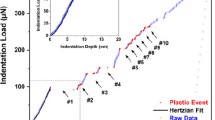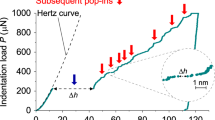Abstract
A simple stochastic model is developed to determine the pop-in load and maximum shear stress at pop-in in nanoindentation experiments conducted with spherical indenters that accounts for recent experimental observations of a dependence of these parameters on the indenter radius. The model incorporates two separate mechanisms: pop-in due to nucleation of dislocations in dislocation-free regions and pop-in by activation of preexisting dislocations. Two different types of randomness are used to model the stochastic behavior, which include randomness in the spatial location of the dislocations beneath the indenter and randomness in the orientation of the dislocations, i.e., randomness in the stress needed to activate them. In addition to correctly predicting the experimentally observed average maximum shear stress at pop-in, the model also correctly describes the scatter in pop-in loads and how it varies with indenter radius. Monte Carlo simulations are used to validate the model and visualize the scatter expected for a limited number of tests.











Similar content being viewed by others
References
H. Bei, S. Shim, G.M. Pharr, and E.P. George: Effects of pre-strain on the compressive stress–strain response of Mo-alloy single-crystal micropillars. Acta Mater. 56, 4762 (2008).
H. Bei, S. Shim, E.P. George, M.K. Miller, E.G. Herbert, and G.M. Pharr: Compressive strengths of molybdenum alloy micro-pillars prepared using a new technique. Scr. Mater. 57, 397 (2007).
M.D. Uchic, D.M. Dimiduk, J.N. Florando, and W.D. Nix: Sample dimensions influence strength and crystal plasticity. Science 305, 986 (2004).
M.D. Uchic and D.A. Dimiduk: A methodology to investigate size scale effects in crystalline plasticity using uniaxial compression testing. Mater. Sci. Eng., A 400, 268 (2005).
J.R. Greer, W.C. Oliver, and W.D. Nix: Size dependence of mechanical properties of gold at the micron scale in the absence of strain gradients. Acta Mater. 53, 1821 (2005).
K.J. Hemker and W.N. Sharpe: Microscale characterization of mechanical properties. Annu. Rev. Mater. Res. 37, 93 (2007).
D. Kiener, W. Grosinger, G. Dehm, and R. Pippan: A further step towards an understanding of size-dependent crystal plasticity: In situ tension experiments of miniaturized single-crystal copper samples. Acta Mater. 56, 580 (2008).
D. Kiener, C. Motz, T. Schoberl, M. Jenko, and G. Dehm: Determination of mechanical properties of copper at the micron scale. Adv. Eng. Mater. 8, 1119 (2006).
O. Kraft, P.A. Gruber, R. Monig, and D. Weygand: Plasticity in confined dimensions. Annu. Rev. Mater. Res. 40, 293 (2010).
A.S. Schneider, B.G. Clark, C.P. Frick, P.A. Gruber, and E. Arzt: Effect of orientation and loading rate on compression behavior of small-scale Mo pillars. Mater. Sci. Eng., A 508, 241 (2009).
C.A. Volkert and E.T. Lilleodden: Size effects in the deformation of sub-micron Au columns. Philos. Mag. 86, 5567 (2006).
M.D. Uchic, D.M. Dimiduk, J.N. Florando, and W.D. Nix. Exploring specimen size effects in plastic deformation of Ni3(Al, Ta), in Defect Properties and Related Phenomena in Intermetallic Alloys, edited by E.P. George, H. Inui, M.J. Mills, and G. Eggler (Mater. Res. Soc. Symp. Proc. 753, Warrendale, PA, 2002).
M.D. Uchic, P.A. Shade, and D.M. Dimiduk: Plasticity of micrometer-scale single crystals in compression. Annu. Rev. Mater. Res. 39, 361 (2009).
W.D. Nix and H. Gao: Indentation size effects in crystalline materials: A law for strain gradient plasticity. J. Mech. Phys. Solids 46, 411 (1998).
J.G. Swadener, E.P. George, and G.M. Pharr: The correlation of the indentation size effect measured with indenters of various shapes. J. Mech. Phys. Solids 50, 681 (2002).
S. Shim, H. Bei, E.P. George, and G.M. Pharr: A different type of indentation size effect. Scr. Mater. 59, 1095 (2008).
P.S. Phani, K.E. Johanns, G. Duscher, A. Gali, E.P. George, and G.M. Pharr: Scanning transmission electron microscope observations of defects in as-grown and pre-strained Mo alloy fibers. Acta Mater. 59, 2172 (2011).
A. Barnoush, M.T. Welsch, and H. Vehoff: Correlation between dislocation density and pop-in phenomena in aluminum studied by nanoindentation and electron channeling contrast imaging. Scr. Mater. 63, 465 (2010).
M.A. Lodes, A. Hartmaier, M. Goken, and K. Durst: Influence of dislocation density on the pop-in behavior and indentation size effect in CaF2 single crystals: Experiments and molecular dynamics simulations. Acta Mater. 59, 4264 (2011).
A. Barnoush: Correlation between dislocation density and nanomechanical response during nanoindentation. Acta Mater. 60, 1268 (2012).
K. Sekido, T. Ohmura, T. Hara, and K. Tsuzaki: Effect of dislocation density on the initiation of plastic deformation on Fe-C steels. Mater. Trans. 53, 907 (2012).
E.T. Lilleodden and W.D. Nix: Microstructural length-scale effects in the nanoindentation behavior of thin gold films. Acta Mater. 54, 1583 (2006).
J.R. Morris, H. Bei, G.M. Pharr, and E.P. George: Size effects and stochastic behavior of nanoindentation pop in. Phys. Rev. Lett. 106, 165502 (2011).
K.E. Johanns, A. Sedlmayr, P. Sudharshan Phani, R. Mönig, O. Kraft, E.P. George, and G.M. Pharr: In-situ tensile testing of single-crystal molybdenum-alloy fibers with various dislocation densities in a scanning electron microscope. J. Mater. Res. 27, 508 (2012).
T.L. Li, H. Bei, J.R. Morris, E.P. George, and Y.F. Gao: Scale effects in convoluted thermal/spatial statistics of plasticity initiation in small stressed volumes during nanoindentation. Mater. Sci. Technol. 28, 1055 (2012).
P. Sudharshan Phani, K.E. Johanns, E.P. George, and G.M. Pharr: A simple stochastic model for yielding in specimens with limited number of dislocations. Acta Mater. 61, 2489 (2013).
A.H.W. Ngan, L. Zuo, and P.C. Wo: Size dependence and stochastic nature of yield strength of micron-sized crystals: A case study on Ni3Al. Proc. R. Soc. Lond. A 462, 1661 (2006).
T.A. Parthasarathy, S.I. Rao, D.M. Dimiduk, M.D. Uchic, and D.R. Trinkle: Contribution to size effect of yield strength from the stochastics of dislocation source lengths in finite samples. Scr. Mater. 56, 313 (2007).
J.A. El-Awady, M. Wen, and N.M. Ghoniem: The role of the weakest-link mechanism in controlling the plasticity of micropillars. J. Mech. Phys. Solids 57, 32 (2009).
A.H.W. Ngan: An explanation for the power-law scaling of size effect on strength in micro-specimens. Scr. Mater. 65, 978 (2011).
R. Gu and A.H.W. Ngan: Dislocation arrangement in small crystal volumes determines power-law size dependence of yield strength. J. Mech. Phys. Solids 61, 1531 (2013).
A.C. Fischer-Cripps: Introduction to Contact Mechanics (Springer, New York, 2000).
M.T. Huber: Zur Theorie der Berührung fester elastischer Körper. Annal. Phys. 319, 153 (1904).
G.E. Dieter: Mechanical Metallurgy (McGraw-Hill, New York, 1976).
R.I. Barabash: Unpublished work.
S. Ogata, J. Li, N. Hirosaki, Y. Shibutani, and S. Yip: Ideal shear strain of metals and ceramics. Phys. Rev. B 70, 104104 (2004). APPENDIX A: Elastic stress field under a spherical indenter at an applied load F
Acknowledgment
This work was supported by the U.S. Department of Energy, Office of Basic Energy Sciences, Materials Sciences and Engineering Division.
Author information
Authors and Affiliations
Corresponding author
Appendices
Elastic stress field under a spherical indenter at an applied load F
For an isotropic elastic material with Young’s modulus E and Poisson’s ratio ν, the stress components in a cylindrical coordinate system (r, θ, z) for indentation by a spherical indenter with radius, R, and contact radius, a, are given by32,33
where
Other important relations are
and
where Ei and E are the moduli of the indenter and specimen and νi and ν are their Poisson’s ratios, respectively.
The maximum principal shear stress (τmax) and the corresponding angle (θ) that it makes with the r-axis [see Fig. 7(a) ] can be calculated from these equations using Mohr’s circle concepts. They are given by34 }
where
and
Area enclosed within a maximum principal shear stress contour
The area enclosed within a maximum principal shear stress contour, τ, as schematically shown by the shaded region in Fig. 5, can be determined by dimensional analysis. Let the spatial coordinates be normalized by the contact radius, a, and the stress components by the elastic modulus, E, such that
where the bars over the symbols (e.g., \(\bar r,\bar z\)) represent the nondimensional quantities. The enclosed area, A, within a maximum principal shear stress contour can then be nondimensionalized as
and the stress components shown in Appendix A can be rewritten in nondimensional form as
Hence,
From Eqs. (B2) and (B4), the maximum principal shear stress can be written as
Thus, for a maximum principal shear stress contour of τ (see Fig. 5), the enclosed area can be written as
where k is a proportionality constant that is a function of Poisson’s ratio ν, and Fτ is the minimum load required to generate a maximum shear stress of τ in the specimen. The value of Fτ can be determined from Hertzian elastic contact theory through the following relation:
The value of the constant k can be obtained by fitting the numerically determined areas enclosed in the contours of maximum principal shear stresses for Hertzian elastic contact as a function of Poisson’s ratio. It is well approximated by Eq. (1b)
Probability of pop-in due to activation of preexisting dislocations
In the proposed weak-link model [see Fig. 5(b)], pop-in occurs by activation of dislocations at a load F if at least one dislocation is activated within the τcrss contour. Let the specimen have n dislocations randomly oriented and spaced. The probability of at least one dislocation being activated is one minus the probability that none of the dislocations are activated. For dislocations not to be activated within the τcrss contour, either there should be no dislocations within the contour or the shear stress acting on the dislocations should be lower than their activation stress. This probability p(F) can be written as follows:
Note that for a given dislocation
where pact is the probability of activation.
To calculate the probability that no dislocations are activated within the τcrss contour, the area inside the τcrss contour can be discretized into N smaller equal-area elements of area ΔA [see Fig. 5(b) ]. The probabilities of no dislocations being activated within each area element can then be multiplied to obtain the probability of no dislocations being activated within the entire τcrss contour.
For a specimen having n dislocations (n → ∞) with a dislocation density ρ, the probability of finding i dislocations within an area is given by26 }
Hence, the probability that there are no dislocations within an area ΔA is
The probability that none of the dislocations within the infinitesimal area elements ΔA are activated can then be written as
Substituting Eqs. (C4) and (C5) in Eq. (C1) and multiplying the probabilities of all the area elements (1 to N), we obtain
The above equation can be simplified to
Probability of activation (pact) of preexisting dislocations randomly oriented relative to the direction of maximum principal shear stress (case 2)
For the dislocation to be activated within the jth contour of maximum principal shear stress τj, the resolved shear stress acting to move it on its glide plane should be greater than τcrss. The probability of such an event can be written using Eq. (7) as
The absolute value of the resolved shear stress is used in this analysis as the activation depends only on the magnitude of the shear stress.
The probability of activation pact can then be calculated as the ratio of the range of angles that satisfy the condition, |cos[2(θ − α)]| ≥ τcrss/τj to the total range of angles for 2(θ − α), which is 5π (−π to 4π). Since the cosine function is cyclical and its absolute value is of interest in the present case, we can calculate the range of angles that satisfy the above inequality for a smaller range such as 0 to π and then extend it to the total range (−π to 4π) by multiplying by 5. The range of angles between 0 and π that satisfy the condition |cos[2(θ − α)]| ≥ τcrss/τj is 2θ*, where θ* = cos−1(τcrss/τj). Hence, the probability of activation for the entire range of angles is
Rights and permissions
About this article
Cite this article
Sudharshan Phani, P., Johanns, K.E., George, E.P. et al. A stochastic model for the size dependence of spherical indentation pop-in. Journal of Materials Research 28, 2728–2739 (2013). https://doi.org/10.1557/jmr.2013.254
Received:
Accepted:
Published:
Issue Date:
DOI: https://doi.org/10.1557/jmr.2013.254




